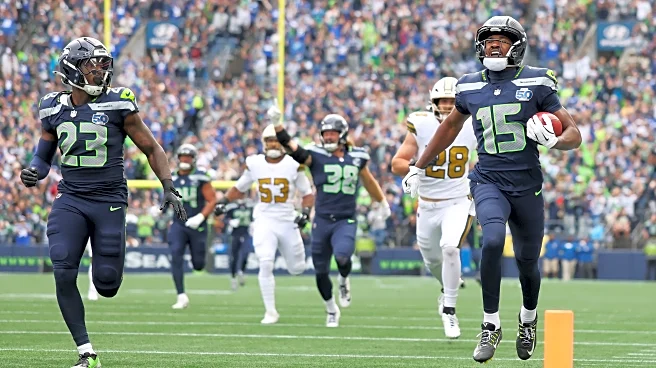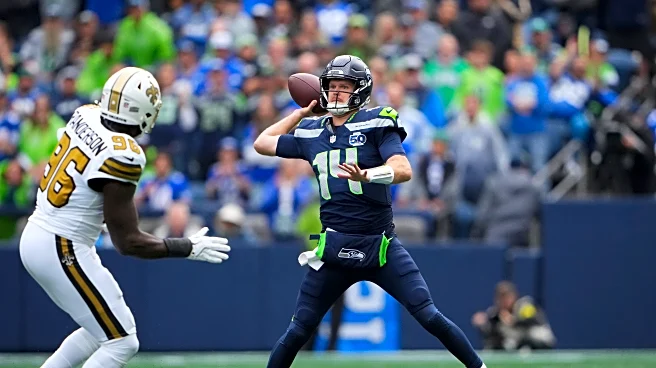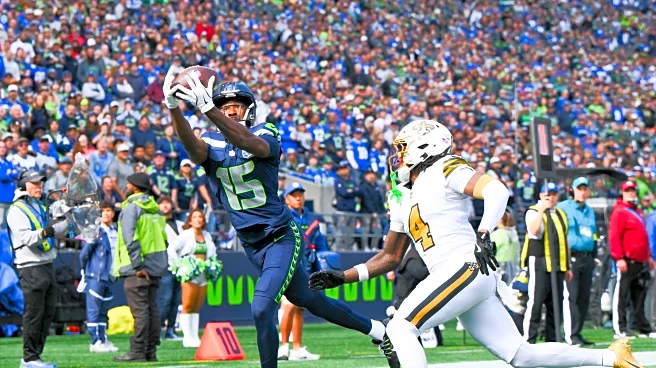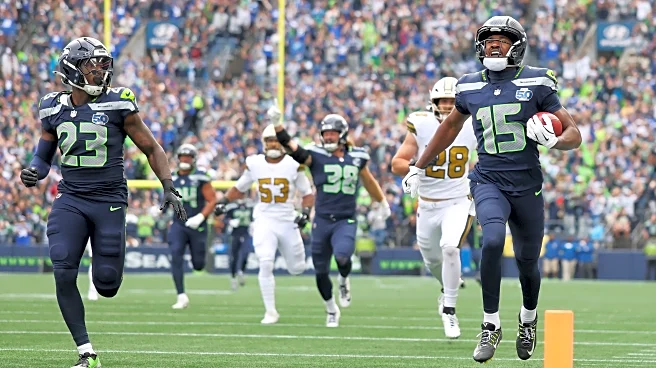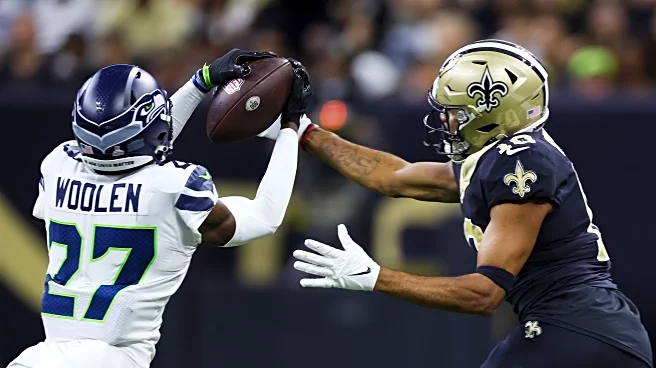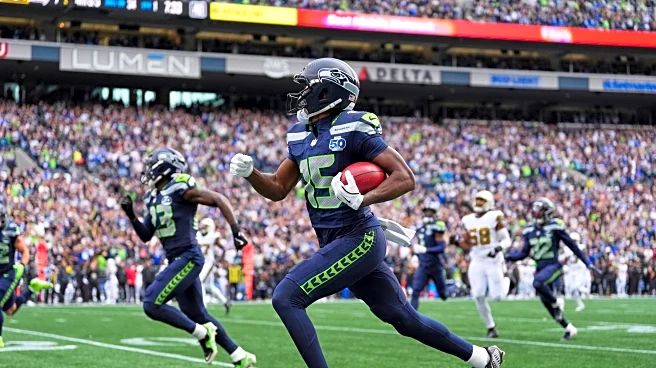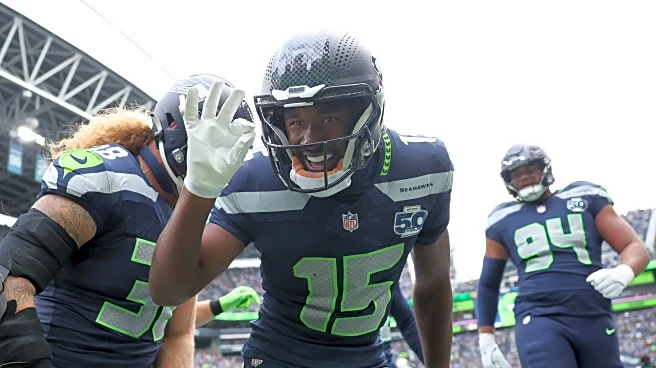The Seattle Seahawks managed to win the trap game. The New Orleans Saints are probably the worst team in the NFL, but Seattle has a long history of losing games when they’re favored. This type of game is dangerous
because if you win, you feel like you’ve just fulfilled your obligation, but if you lose, pressure builds and raises several questions about the team.
Seattle did what it had to do in this game: win with authority. The game was essentially decided before the end of the first quarter. In fact, almost the entire second half was spent with the Seahawks running down the middle and waiting for the clock to run out.
With the victory, the Seahawks broke several records:
- Tory Horton scored the longest punt return TD in franchise history (95 yards);
- Tory Horton became the third player in Seahawks history (the others are: Bobby Engram vs. Detroit Lions in 2003, Joey Galloway vs. San Diego Chargers in 1998) to record a receiving touchdown and a punt return touchdown in the same game;
- 21 points in the first quarter tied the franchise record set against the Giants in 2006;
- JSN reached 183 career receptions, surpassing Koren Robinson (the last Seahawks receiver drafted in the first round before JSN) and becoming the fourth-most in the first three seasons by a player in franchise history;
- 38 first-half points are the third-most in a half in franchise history;
- It was the fifth time in franchise history and the first time since 2013 that the Seahawks held their opponents to 17 points or fewer in the first three games of the season;
All data used in this article was taken from PFF.
The Bad
The inconsistent offensive line (especially in the running game)
This will likely be a recurring topic in post-game analysis. The offensive lineman makes a big play, and two snaps later, the lineman loses the same play. Other times, while some make the right play, a single player’s mistake ruins everything. The 2.6-yard average per carry is a result of this.
I don’t think anyone is surprised by Anthony Bradford’s performance. The position wasn’t addressed in the FA and the Draft, leaving Bradford as the best option on the roster. Bradford has been playing poorly (based on his PFF grade), including in the running game, which should be his greatest strength.
On this play, he simply doesn’t block the blitzer; the pass is deflected, and Sam Darnold is almost sacked. He displays a certain passivity at times that’s irritating.
He probably made a mistake on this play as well, but since I can’t say with 100% certainty about the call, I won’t say for sure. The right side of the line has three threats: the 3-tech, the edge, and a blitzer. The OL is moving to the left side, which could indicate that the right side will block man-to-man, leaving Bradford with Bryan Bresee (#90).
Bradford simply lets the player pass, and this is not only risky for the play but also for Sam Darnold’s health. He may have thought the center would move to that side, hence the mistake. One of the most common mindsets when blocking is to protect the most inside threat, and Bradford didn’t do the basics.
As mentioned at the beginning of the thread, making mistakes isn’t exclusive to Bradford. On the play above, the OL’s five were defeated. Bradford and Abe Lucas should have blocked the DT, and the RG should have moved up to the second level. Bradford doesn’t help much, and Lucas can’t get in front of the defender. The RG also can’t block the LB at the second level (#20). This compromises the play and causes the C, LG, LT to be unable to sustain their blocks, resulting in the failure of the run.
Missed opportunities by the Seahawks defense
The Seahawks defense has been dominant, but there’s still room for improvement. They had 28 pressures for just 2 sacks, and this efficiency has been a recurring issue.
Boye Mafe gets a good win against the LT, even connecting with Spencer Rattler, but can’t get the QB to the ground. This allows the QB to improvise, finding Alvin Kamara, who can still get a first down. This missed sack could be the difference between a win and a loss in tougher games.
The Saints call a well-identified screen by Boye Mafe. The edge again has a chance to finish the play, but misses. The defense manages to make the play, but, once again, it’s a missed opportunity.
Other points of concern
Three other points stood out to me about the defense’s play that could be improved:
- Discipline: Many fouls were committed, which saved plays for the Saints, keeping drives alive. I know it must be difficult to stay focused with a score like that, but it’s something that MUST be improved;
- One detail is that the Saints used the no-huddle a lot, and at times the defense seemed unprepared or unpositioned. Some teams might recognize this and use it better against Seattle than the Saints did;
- Difficulty keeping the QB in the pocket: This could have been discussed in the previous section, but I’ve included it here. The pressure builds, but the defensive line can’t keep the QB in the pocket. In Week 1, on a very similar play, Brock Purdy scored the game-winning TD, even after being hit. Here, Rattler manages to escape, buy time, and score the TD.
The Good
Ken Walker being Ken Walker
Walker had just 38 yards on 16 carries, but two touchdowns. The numbers aren’t impressive due to the inconsistent offensive line, which appears to have taken a step back in the running game. The RB, who is in the final year of his contract, will be a major problem for opponents when (if) the offensive line adjusts.
This is Walker’s first touchdown. Note how the left side of the line does an excellent job. However, Bradford loses his block almost instantly. To avoid being tackled in the backfield, Walker has to change direction but still manages to find the end zone.
Walker’s second touchdown of the game also has much merit. The target of the run was the gap formed by the blocking of the cornerback and the puller. Walker starts the play with this objective, but the Saints manage to seal the edge by forcing the cutback. Great blocking by Charles Cross, who has been improving significantly in the running game, and Jalen Sundell who helps the RB get into the end zone.
Here’s an example of Ken Walker’s experience. Yes, at times he’ll frustrate by not following the first read (something he’s been improving at this season compared to previous years), but at other times he simply works magic. Grey Zabel quickly loses his block and leaves the DT with a clear path to the RB. Walker escapes a solid tackle, but the play doesn’t end there. He tries to gain yards (or not lose so many) and ends with a hurdle over the CB.
Sam Darnold and Klint Kubiak
Kubiak and Darnold are starting to get more comfortable. Sam Darnold posted the highest completion rate of his career, 77.8%, in Week 3. He was successful on the field, completing 6 of 8 passes that went over 10 yards for 146 yards and a touchdown. Darnold’s completion average was 10.3 yards.
Here we have excellent play-action. The play-action moves the safety (#21) toward the line. Cooper Kupp’s route, which runs a free release protected by AJ Barner, moves the cornerback, creating ample space for JSN’s route coming from the opposite side. Darnold is protected, has a simple read, and executes the pass well for #11 to get his first TD of the year.
The motion denotes man-to-man coverage. From the snap, the first read is Tory Horton running a quick fade. Darnold, aware of the M2M defense, places the ball further to the sideline to make things easier for Horton, who tracks the ball and stretches his arms for his third TD in three games.
A blunder by the OL leaves Darnold in a terrible situation. He escapes the seemingly imminent sack. He buys time and throws to JSN, again throwing against the body movement. JSN’s excellent work in identifying the scramble pattern and adjusting his route to help the QB deserves special mention.
The Seahawks call a play-action Mid Shot here. JSN runs a good route, threatening vertically to manipulate the CB before cutting back on the post route. Darnold gets hit here, the pass comes behind JSN, who needs to slow down and receive it in the middle of three defenders. If this pass goes forward, we would likely have had a TD.
Special Teams truly being special
Jay Harbaugh hadn’t had a great game for Seattle yet. Last year, we had a lot of return issues, with turnovers and questionable coverage. Things looked like they would get worse with poor preseason play, but the Saints’ performance provided a huge relief for the coordinator, who is only in his second NFL season, with a blocked punt and a touchdown.
The team rightly chose to punt in the direction of Kendre Miller. Everyone remained disciplined in defending their lanes, allowing Drake Thomas to make an excellent tackle. The coverage work was good, limiting the Saints’ turnovers. The big return was a punt in the second half (where concentration may not have been the same).
Derek Young also managed good returns, especially the one above, where the kicker showed Sebastian Janikowski-level effort to make the tackle.
A great return by Tory Horton, who escapes the gunner and takes advantage of key blocks from his teammates. The CB Nehemiah Pritchett makes the first block on the verge of committing a penalty. Then, watch for Jake Bobo and Jerrick Reed creating the lane for the return. Finally, Chazz Surratt runs over the punt, and almost halfway down the field, Horton has the chance to slow down and still score the TD.
Final Thoughts
A comfortable victory for the Seahawks. So comfortable that many starters rested more than a quarter. This is crucial when you have to travel to face an opponent on a short TNF week.
The numbers and results were already very good. Imagine where this team could go if the OL becomes consistent and the defense takes advantage of most of its opportunities?
Go ‘Hawks!

